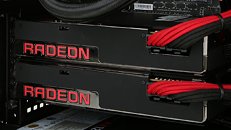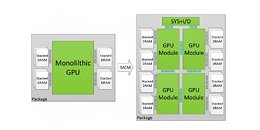Thursday, August 22nd 2019

AMD CEO Lisa Su: "CrossFire Isn't a Significant Focus"
AMD CEO Lisa Su at the Hot Chips conference answered some questions from the attending press. One of these regarded AMD's stance on CrossFire and whether or not it remains a focus for the company. Once the poster child for a scalable consumer graphics future, with AMD even going as far as enabling mixed-GPU support (with debatable merits). Lisa Su came out and said what we all have been seeing happening in the background: "To be honest, the software is going faster than the hardware, I would say that CrossFire isn't a significant focus".
There isn't anything really new here; we've all seen the consumer GPU trends as of late, with CrossFire barely being deserving of mention (and the NVIDIA camp does the same for their SLI technology, which has been cut from all but the higher-tier graphics cards). Support seems to be enabled as more of an afterthought than a "focus", and that's just the way things are. It seems that the old, old practice of buying a lower-tier GPU at launch and then buying an additional graphics processor further down the line to leapfrog performance of higher-performance, single GPU solutions is going the way of the proverbial dodo - at least until an MCM (Multi-Chip-Module) approach sees the light of day, paired with a hardware syncing solution that does away with the software side of things. A true, integrated, software-blind multi-GPU solution comprised of two or more smaller dies than a single monolithic solution seems to be the way to go. We'll see.
Source:
TweakTown
There isn't anything really new here; we've all seen the consumer GPU trends as of late, with CrossFire barely being deserving of mention (and the NVIDIA camp does the same for their SLI technology, which has been cut from all but the higher-tier graphics cards). Support seems to be enabled as more of an afterthought than a "focus", and that's just the way things are. It seems that the old, old practice of buying a lower-tier GPU at launch and then buying an additional graphics processor further down the line to leapfrog performance of higher-performance, single GPU solutions is going the way of the proverbial dodo - at least until an MCM (Multi-Chip-Module) approach sees the light of day, paired with a hardware syncing solution that does away with the software side of things. A true, integrated, software-blind multi-GPU solution comprised of two or more smaller dies than a single monolithic solution seems to be the way to go. We'll see.


88 Comments on AMD CEO Lisa Su: "CrossFire Isn't a Significant Focus"
I am interested in the MCM though. It wouldn't need any support from Developers because, as I understand it, the multiple chips are treated as one GPU.MS just said that crap about DX12 being able to pair an AMD card with a Nvidia card to push Win 10. They knew they couldn't do it.
But now with the low lag times required by some games and showing up badly on graphs I can see why hardware vendors are moving away from it. I guess my next upgrade will be crossfire free for the first time in over a decade...
BTW, it is nice to have, now with pascal RTX support, every performance bit is useful.
Isn't that the perfect situation to make multiple GPUs work? I mean if they can't keep up with software's hardware demand with a single card, then "just throw in more".
Since AMD doesn't have a real high-end card it would seem like a good idea to focus on CrossFire, but I guess it's not only their fault. Game developers would need a bit of extra work to make scaling efficient and that's not worth it for them, or either their partner GPU vendor (Which is usually Nvidia with their ****Works)
A dual 5700 XT (or many cheap cards) setup would beat a 2080 TI for much less money in ideal situations and that would make the most expensive card irrelevant.
The other big factor I think was DX12 and the thinking that it would lead to multiplying gpu power by leveraging multiple cards even of different makes and models. In practice it ended up not being all it was cracked up to be in that aspect. Even though it didn't make SLI/Crossfire obsolete, DX12 looking like it was going to make those obsolete I'm sure didn't help with R&D funds being allocated to those areas.
And lastly GPU power reached the point that you can game comfortably even with high resolutions and maxxed settings with 1080ti+ type cards without the need for SLI/Crossfire. And with all of the driver issues and bugs that SLI/Crossfire add, it's just not worth the trouble.
Maybe you are not up to date with GPU tech ......
And almost no vendor uses the native multi-gpu support.
Bottom line is that it has the same advantages as AMD's other MCM offerings, so why the hell not? Even if they were to fail, it would be a valiant effort.
Multiadapter was supposed to be able to make it easy for developers to utilize multiple gpu's any gpu even integrated all at the same time. apparently MS didn't make it easy enough though because no one used it.
developer.nvidia.com/vrworks/graphics/vrsli
Also, after simultaneous multiprojection came out, there was less of a performance gain from using two cards instead of one. When one card can process both geometries without a performance hit, your main reason for having two GPUs is gone. And it's a lot easier to code for, and you don't run into situations where the framerate differs between the eyes, which I could imagine being an extremely uncomfortable sensation. Especially since the VR headsets are currently running at fixed framerates with VSync, so you would essentially have one eye seeing a frame twice while the other sees something different. It would probably feel like crossing your eyes or having a stroke.
Here's the information on SMP
www.anandtech.com/show/10325/the-nvidia-geforce-gtx-1080-and-1070-founders-edition-review/11
www.apple.com/mac-pro/specs/
if you were in their shoes dealing with budget and crunch woes, would you create more work for yourself for the whole two people in the world that use crossfire? That will give you absolutely zero returns?